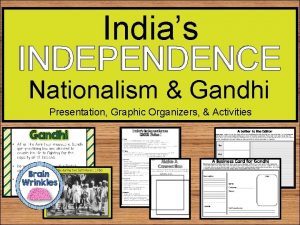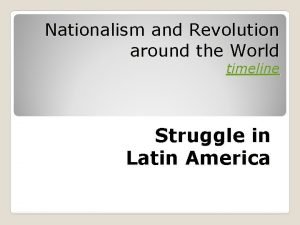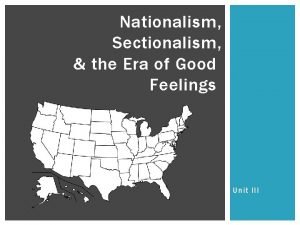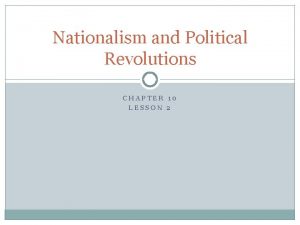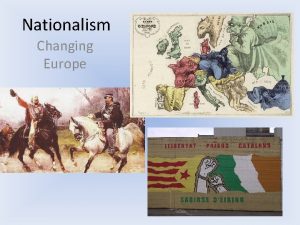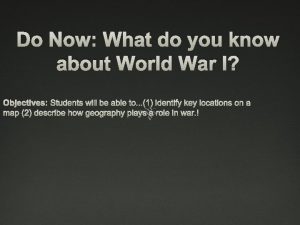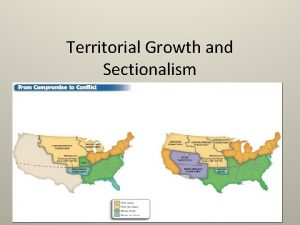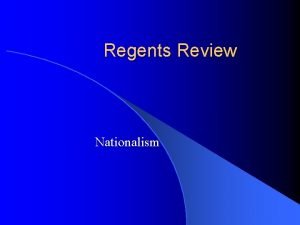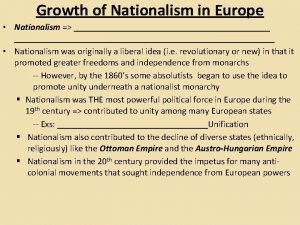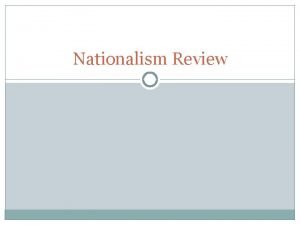Theories of Nationalism Theories of Nationalism Nationalism as










- Slides: 10

Theories of Nationalism

Theories of Nationalism • Nationalism as a major force during the past 2 centuries. • Pre-capitalist political and social affiliation: tribes, feudalism, dynastic empires • Link between nationalism and modernity: capitalism, industrialization • Emergence of nationalist in Europe in 18 th century and its spread

• Nation is not a physical entity but a sentiment • Nation is a collection of people bound together by common values and traditions, often sharing the same language, history and affiliation to a geographical area • Members identify themselves define themselves against others

Benedict Anderson • Nations are “imagined communities” • Nations are imagined by people who perceive themselves as part of that group • It is not based on every-day interaction among people who perceive themselves as members of that nation

What are the main factors that led to the rise of nationalism? • “Print Capitalism” • Capitalist entrepreneurs printed books in vernacular languages such as Latin • People speaking various local dialects became able to understand each other • European nation-states were formed around “national printlanguages”

Role of Printing • • Printing played a major role in spreading ideas By 1500 about 20 million books had been printed and circulated in Europe Role of print in the success of religious reformation Martin Luther publications formed 1/3 of all books in Germanic languages during the Reformation

• Development of other vernaculars such as Anglo-Saxon and Norman French • Use of vernaculars for administrative purposes by the ruling elite • Decline of Latin as a language that unified the “Christian community” • Print industry helped the spread of these vernaculars

How did print languages contribute to the development of national consciousness? • • • They created an environment of exchange and communication People communicated through paper Fellow readers formed the seed of nationally imagined community Print-capitalism solidified these languages By the 17 th century languages in Europe assumed their modern form Convergence of capitalism and print paved the way for the rise of modern nation states in Europe in 18 th and 19 th centuries • Nation-state became the only model of political organization

Changing Dynamics of Nationalism • • Liberal ideology championed nationalism until WW 2 Nationalism can take various forms: Nazis and Fascists Marxists viewed nationalism as a backward form of consciousness Recent intellectual writings considered nationalism and nation-state as outdated Some post-colonial writers considered nationalism as an elite project Desire to transcend national boundaries and to create a broader form of belonging Pan-Africanism, Pan Arabism, Pan Islamism

• To what extent is the concept of imagined communities relevant to the question of how modern nation-states frame their identities, domestic, and foreign polices • National politics of today
 Gandhi presentation
Gandhi presentation Chapter 35 nationalism and political identities in asia
Chapter 35 nationalism and political identities in asia Nationalism triumphs in europe
Nationalism triumphs in europe Nationalism and revolution around the world
Nationalism and revolution around the world To what extent should we embrace nationalism
To what extent should we embrace nationalism Era of good feelings nationalism and sectionalism
Era of good feelings nationalism and sectionalism Nationalism and political revolutions lesson 2
Nationalism and political revolutions lesson 2 Define balkans
Define balkans Balkan nationalism
Balkan nationalism Nationalism vs sectionalism
Nationalism vs sectionalism How did the gibbons v ogden decision promote nationalism
How did the gibbons v ogden decision promote nationalism
